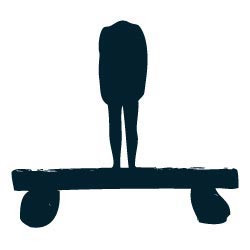Balance is a word we use when we want to say that something is even and stable. If a cup of water is not balanced on a table, it will fall over and the water will spill. A balanced cup will stay upright and won’t fall down. You can walk in a straight line if you have good balance. If you don’t have good balance (meaning you are not even and stable), then you will not walk in a straight line.
We can see balance in the sculptures that artists make. This artist made a sculpture that balances a figure on a shelf. The shelf is also balanced on two logs.
What is unusual about the figure in this sculpture?
Does the figure look stable?
Which piece looks the heaviest?
Which piece looks the lightest?
Would it be easy or hard to balance on two logs?
What would happen if the logs rolled away?
Note the distinction between physical balance and visual balance. Point out both qualities in this sculpture.
Have the child find objects with different shapes, sizes, and weights. Ask him or her to try balancing them in different ways. Note that it is hard to balance things on round objects and it is easier if the lower objects are flat. It is also easier if lower objects are larger and heavier than the objects on top of them. When the child successfully balances objects, look at the form and ask if it is visually balanced as well.
Artist - someone who makes things, such as paintings and sculptures
Balance - to keep steady
Figure - a human shape
Sculpture - a work of art that has height, width, and depth
Stability - being firmly established, fixed, and not moving

